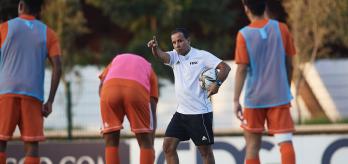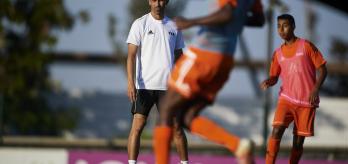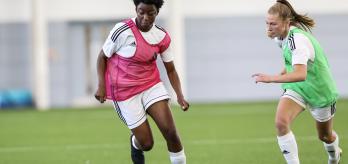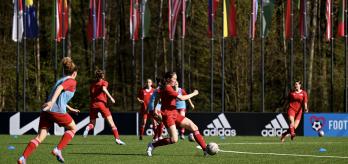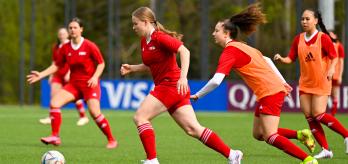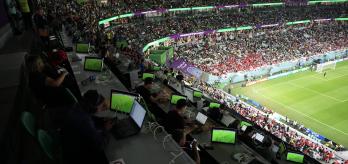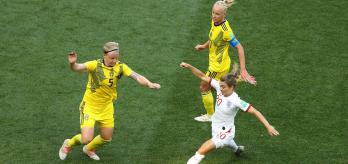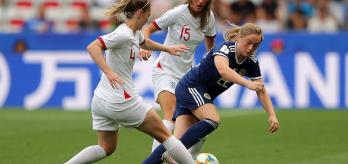There are typically two approaches to defensive transitions: a team either try to win the ball back immediately (counter-pressing), or they look to recover into their defensive shape so that they can start an out-of-possession phase and prevent the opposition from progressing towards their goal.
Morocco’s U-15 national-team coach, Abdallah Idrissi, leads a group of players through a session designed to improve their ability to recover their shape once they lose possession, especially in the build-up phase. The session starts with a warm-up including 1v1 and 1v2 scenarios. It then moves into a possession game including transition phases. The players then take part in a match with zonal restrictions, before finishing off with a 7v7 match on a reduced-size pitch where they can evaluate their understanding and the main takeaways from the session.
Session overview
-
The closest player to the ball must immediately react to the transition and press to prevent the ball carrier from playing forward either through a pass or by carrying the ball.
-
Team-mates must get back into the team’s defensive shape as quickly as possible to form a compact block and restrict space for the opponents. The backline should squeeze tight, with the 4 defenders maintaining the defensive line.
-
Players should try to create a numerical advantage around the ball to increase the chances of regaining possession.
-
Communication across the team is essential to succeed. Players should guide and give instructions to the team-mate(s) in front of them as they have a better view of the pitch from a position that is further back.
Part 1: "pass and follow", progressing into 1v2
The session begins with a technical warm-up during which the players are split into groups of three across four different lanes. First, they take part in a simple "pass and follow" exercise and then they perform dynamic stretches after every pass (knees up, heel flicks, hip flexes, etc.), before moving onto a transition-focused exercise in which they will be placed in different realistic 1v2 scenarios that players might encounter in a game.
-
Mark out 4 lanes each measuring 24x8m and align them horizontally. Each lane should be 2m apart.
-
Using 2 poles, mark out a 4m-wide gate in the middle of the lane.
-
Divide 12 players into 4 groups of 3 and assign them to 1 lane each.
-
The same sequence of events applies to each of the 4 lanes.
-
Position 2 blue players at one end of the lane and an orange player at the other end.
-
The 2 blue players start with the ball.
-
1 blue player should carry the ball forward and pass it to the orange player just before they reach the gate.
-
This first player should follow their pass and replace the orange player, who then performs the same “pass and follow” sequence back to the other end.
-
As they follow their passes, players perform the following stretches in sequence:
-
Knees up
-
Heel kicks – players run across to the other side
-
Hip flexes
-
Backwards jog – player turns halfway
-
Players are encouraged to use both feet when on the ball, as well as to take different types of touches (with the inside/outside of the foot, laces, etc.).
-
Instead of following their pass, the passing player lightly presses the receiver.
-
The receiver should perform a skill to dribble past them and carry the ball forward.
-
They then take the passing player’s position at the other end of the pitch.
Players are split into a 1v2 formation in each lane.
-
1 of the blue players passes the ball to the receiver (the orange player).
-
That blue player then follows their pass and presses the receiver to try to regain possession.
-
Once the first blue player crosses the halfway line, the second blue player joins in to create a 1v2.
-
If the orange player successfully evades the press and carries the ball through the gate, they score a point.
-
The 2 defenders earn a point if they regain possession and dribble over the opposite end line.
These exercises are now completed one group at a time.
-
1 of the blue players starts with the ball on the edge of the area, at the halfway line.
-
They start by passing the ball to the second blue player, who is inside their own half.
-
The second blue player passes it to the orange player.
-
Once the orange player receives the ball, both blue players press the receiver to create a 1v2 situation. The same scoring applies as in variation 2.
-
1 blue player should be positioned at the opposite end of the pitch and behind the orange player.
-
The second blue player passes the ball to the orange player.
-
Once the orange player receives the ball, both blue players must then press the receiver to try to regain possession. The same scoring used in variations 2 and 3 applies.
-
Players should be alert and react quickly to transitions so that they can press the ball carrier as soon as possession is lost.
-
When possession is lost, the closest player to the ball must press the ball carrier immediately to slow them down and prevent any forward play.
-
Team-mates should try to create a numerical advantage around the ball as quickly as possible to increase the team’s compactness in the area and the chances of regaining possession.
-
Players should give each other instructions and guidance when they are not directly involved in pressing the ball as this means that they have more time to read the situation.
Part 2: 5v3, transitioning into 5v7 – possession game
The next exercise is a possession game in which the players move from a smaller pitch to a bigger pitch, and from overloads to underloads. The design of the drill encourages players to quickly react to defensive transitions. They need to hound the ball as a team in order to lock the opposition into an area of the pitch, surround them and create a numerical advantage to regain possession.
-
Mark out a 24x40m pitch.
-
Place 4 mini-goals at each corner of the pitch.
-
Mark out an 8x15m area in the centre of the pitch.
-
Divide the players into a team of 7 (oranges) and a team of 5 (blues).
-
The 5 blue players and 3 of the orange players start inside the central area.
-
The other 4 orange players are positioned in a diamond shape outside the central area.
-
The game starts inside the central area with a 5v3 possession phase for the blue team.
-
The blue players score a point every time they can complete 5 consecutive passes without the orange players winning the ball.
-
If the orange team win the ball or the ball is forced out of the central area, they must try to play the ball out to one of their 4 team-mates outside of the area.
-
This then creates a 7v5 overload situation and the 7 orange players must try to complete 5 consecutive passes to earn a point, while the blue players try to regain possession.
-
If the blue team regain possession, they should try to score a goal in any of the 4 mini-goals to earn a point.
-
When the ball goes out of play, or a goal is scored, the game restarts inside the central area, with the blue team in possession.
-
The closest player to the ball when possession is lost must press the ball carrier immediately and aggressively to slow them down, limit the space they have and prevent any forward play.
-
Once the ball carrier is pressed, the other defending players should support their team-mate by overloading the area to reduce the space available to the opposition and increase the chances of winning the ball back.
-
Players must make a quick decision on whether to press immediately or cover, while ensuring they synchronise movements with one another.
-
The player pressing the ball should dictate play to their own team-mates so that they can take advantage of the positioning.
-
Players must press as a unit and react in a coordinated way to losing possession.
-
After losing the ball, teams should protect central areas and force the opposition to play out wide.
-
Players must communicate appropriately with the team-mates in front of them to give information about what is happening behind them.
Part 3: 6v6 plus goalkeepers – conditioned match
The 12 outfield players are then joined by two goalkeepers to take part in a 6v6 plus goalkeepers match on a reduced-size pitch. In this game, the players try to play out from the back against a high press, which leads to frequent turnovers of possession in areas close to their own goal. Players must then recover quickly to get into their defensive shape, protect their goal and try to regain possession.
-
Mark out a 40x40m pitch.
-
Divide the pitch into 3 zones, with the central zone being 22m long.
-
Place a full-size goal at each end of the pitch.
-
Split the players into 2 teams of 6 (blues and oranges).
-
Position a goalkeeper in each goal.
-
Both teams are set up in a 1-4-1 formation.
-
The units are positioned inside their respective zones of the pitch when a phase of play starts, but are not restricted to these zones throughout.
-
The ball always starts with either goalkeeper.
-
The team in possession must try to build play from the back and progress through the zones to get inside the final zone and attempt to score a goal.
-
Both teams are organised in a 1-4-1 formation, with players divided across the 3 zones as follows:
-
1 goalkeeper and 1 defender inside the defensive zone.
-
4 midfielders inside the central zone.
-
1 centre-forward inside the final zone.
-
When an attack is being built, players from both teams are locked inside their respective zones.
-
Players are allowed to join their team-mates inside the final zone only once the ball has entered that zone after having been played through each zone.
-
However, if possession is lost, players are allowed to recover and defend inside any zone.
-
The coach can decide which team start with the ball and should ensure that both teams get to practise the build-up and defensive transitions.
-
Change the set-up so that both teams line up in a 2-3-1 formation.
-
When a team lose possession, they must react as quickly as possible to apply pressure on the ball carrier, and recover their defensive organisation.
-
Constant communication amongst the team is essential to adjust collectively and get into good defensive positions.
-
Players must be aware of their own and their team-mates’ positioning, the whereabouts of the ball and the space around them, so that they can identify danger early when losing the ball and react accordingly to protect their goal.
-
As a team, the defending players should deny and reduce space to prevent the opposition from playing forward.
-
The defending team must minimise the space between the lines as well as behind the defensive line to maintain a compact block that is difficult to penetrate.
Part 4: 6v6 plus goalkeepers – match on a reduced-size pitch
The session finishes off with a 6v6 match plus goalkeepers with no restrictions. El Idrissi aims to let the game flow as much as possible without intervening unless the players still need support to execute some of the coaching points shared in the previous exercises.
-
Mark out a 40x40m pitch.
-
Place a full-size goal at each end of the pitch.
-
Split the players into 2 teams of 6 (blues and oranges).
-
Position a goalkeeper in each goal.
-
There are no restrictions apart from normal football rules.
-
When a team lose the ball, their players should immediately react to the transition to protect the centre of the pitch and prevent the opposition from approaching their goal.
-
The player pressing the opponent who has just won the ball must ensure that they are difficult to beat so that they slow down the ball carrier as much as possible, or, even better, force them to play backwards.
-
Players who are not close to the ball, and especially those behind it, should make every effort to run back and help their team maintain a compact defensive block as soon as they lose possession.





